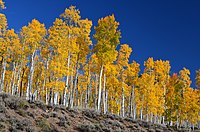
Photo from wikipedia
Abstract In boreal forests and alpine treelines, it is debatable how the temperature sensitivity of tree-ring growth should vary with changes in climate over time and the extent to which… Click to show full abstract
Abstract In boreal forests and alpine treelines, it is debatable how the temperature sensitivity of tree-ring growth should vary with changes in climate over time and the extent to which seasonal stem increments are controlled by leaf physiology. We aim to test the hypothesis that, in cold-limited forests, maximizing stem growth rate around summer solstice is closely related to foliage turnover, which generally results in high sensitivity of stem growth and less sensitivity of nitrogen-use efficiency (NUE) to early-season temperatures. Our analysis was based on repeat-census observations of stem radial increment (2008–2013; made with dendrometers) and monthly litterfall (2007–2015) as well as the measurements of tree-ring width series (1960–2015; made with tree-ring cores) in two Tibetan treeline forests. NUE was estimated as the inverse of leaf-litter nitrogen concentration. We further examined a global dataset of tree-ring chronologies (1931–1990) from 139 sites across temperate and boreal coniferous forests in the northern high-latitude region. Weekly stem increments across species and years synchronously peaked around summer solstice, with more than half of annual increment produced in the first 28–35 days of the growing season when air and soil temperatures were still low. Monthly stem increments were positively related to previous-month litterfall, and higher litterfall generally resulted in higher NUE. NUE was insensitive or less sensitive to soil temperature in the early growing season. Among years, pre-peak increments were positively correlated with pre-solstice temperatures while post-peak increments varied little. The annual increment was dominated by and coherent with the pre-peak increment and well correlated with the ring-width measurements of monitored trees during 2008–2013. Variations in tree-ring width chronologies from the two Tibetan treelines and the global 139 forest sites mainly reflected the change of early summer temperatures. The findings suggest a day-length control on the linkage between seasonal stem growth and nitrogen cycling in a cold-limited forest ecosystem, and provide the basic for predicting responses of tree-ring growth and NUE to climatic warming.
Journal Title: Agricultural and Forest Meteorology
Year Published: 2018
Link to full text (if available)
Share on Social Media: Sign Up to like & get
recommendations!